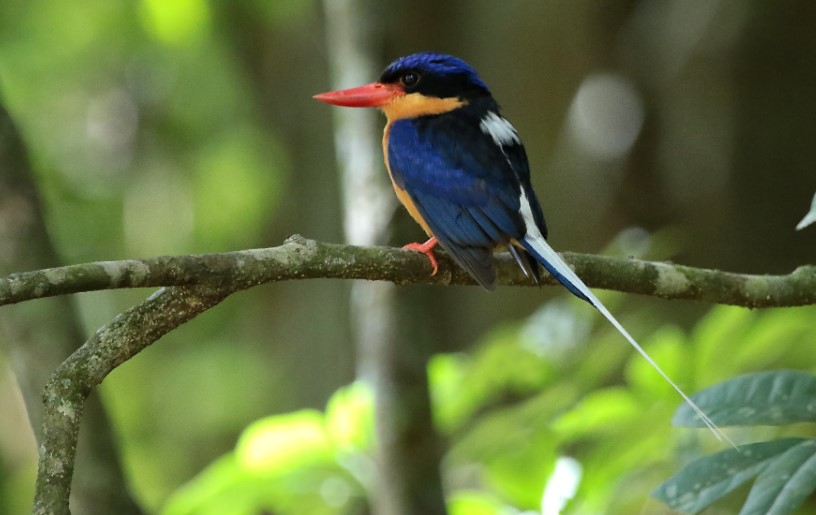In early November each year, buff-breasted paradise-kingfisher (Tanysiptera sylvia) arrive in northern Queensland to breed. A forest will erupt with the sounds of birds establishing territory one afternoon and disappear the next morning. These are also the most attractive times of the year. They look like so many large blue-and-buff butterflies flying and fluttering around in the rainforest since their plumage is neither stained nor worn from the nesting chamber.
Nesting occurs in small termite mounds after the birds have established their territories and paired off. It spends three to four weeks tunneling out a nesting chamber that is left unlined in the side of a mound between 370 and 500 mm high. Approximately a week later, the eggs are laid. Incubation and feeding are done by both parents. Between the end of December and the beginning of January, most chicks hatch.
Four to six days after birth, they have a down covering. Chicks at this age have short, thick bills, which they use to defend themselves against predators. In about two weeks, pin feathers begin to appear, and by 20 days, the bill has almost fully developed. They will attack anything that comes near them and are constantly fighting among themselves, their feathers encased in persistent sheaths, giving them a scaly, reptilian appearance.
When the chicks are awake, they squeak continuously, and the noise gets louder the closer the adult kingfisher comes. By the time the young are ready to leave, their pin-feather sheaths have shed. They stay in the nest for about 24 days. A young bird lands unceremoniously on the ground and flutters quickly to a bush, where it works its way up as it grows stronger.
As the rainforest matures, adults pick up insects, snails, frogs, and lizards from the ground or from low branches. In this case, the Kingfisher is hunting as he normally does. When the young squabble over food, much drops to the floor of the nesting chamber, becoming a carpet of half-decayed prey that scores of maggots of flesh flies (family Tachinidae) crawl through.
During nesting, adults raise and lower their tails slowly backward and forward, or faster if they are calling. When perched on horizontal branches, adults raise and lower their tails slowly backward and forward. The young depart a few days later and are gone by the end of April. They start leaving northern Queensland in late March or early April.
There are several different names for this species of kingfisher, including white-tailed kingfisher and racquet-tailed kingfisher. Including its attenuated pointed 130-mm tail, the Buff-breasted Paradise-Kingfisher measures about 290–320 mm in length.
There is no difference between the sexes. Blue is the color of the adult bird’s crown. A broad black band runs from the forehead to the eye and around the nape. A white rump and back are edged with black. With two long white central streamers and white shafts, the tail is a royal blue color.
A royal blue color covers the wings, and a dusky color covers the tips of light feathers. There is uniform buff-ochre coloration on the underparts. There is a dark brown color to the eyes. There is a bright orange color to the bill. There is a bright coral-red color on the feet, and there is a dark gray color on the claws.

Matt’s dull blue crown and wings, along with a short black tail, are present in immature birds. A dull buff breast contrasts with the dirty gray back and rump. Black is the color of the bill and legs. The territorial call of the buff-breasted paradise kingfisher is an ascending chuga-chuga-chuga repeated four times through a closed bill. When males and females are in contact, they make a soft descending trill; when chasing intruders, they screech.
From November to February, nesting and breeding take place. On the rainforest floor, the bird builds its nest in a 370–500 mm-high termite mound. Nests are usually built on reddish-brown basaltic soils. A bird digs a tunnel about 150 mm long in the side of the mound, leading to a chamber 150 mm across and 130 mm high. A dark, glossy substance often coats the nesting chamber, which is usually unlined.
The white-colored eggs of this magical, gorgeous kingfisher are round, about 26 x 23 mm in size. Both sexes are involved in the incubation process. Four to five weeks after hatching, the young fledge In northeastern Queensland, the Buff-breasted Paradise-Kingfisher breeds from Cape York Peninsula to Townsville; stragglers may reach Mackay. There are only a few populations in lowland rainforests below 600 meters. During the winter, it spends time in central New Guinea. Australia has only one endemic race. The southeastern part of New Guinea and New Britain also have distinctive races.







